The other passengers on the HotBus to Tongariro Crossing ask us if we want to play a game. Tanya and I say, “Sure.” It’s a two-hour ride from Rotorua toward Taupo and it seems like a good way to entertain ourselves. Rachel, originally from New York, but currently living in Germany, asks if we’ve played “Contact” before. Neither of us has.
The way Rachel explains the game, it sounds like a word game of tag. Someone starts by thinking of a word beginning with a certain letter. Other players have to guess the word by asking a question. If other players know the word that the player asking the question is thinking of, they have to say, “3-2-1, Contact!” and say the word at the same time as the player asking the question. If they’ve said the same word, the original player starting the game has to reveal the next letter of the word they are thinking of, helping to generate more questions and guesses. It was a bit confusing in the beginning, but once we started playing, it was tons of fun especially when you are playing with brainy people who choose words like barnacle and mitre, which happened to be the name of my high school year book.
Rachel is visiting her sister Alyssa and her father Brian who now live in Rotorua. Kent and Jo from Massachusetts are visiting, too. They have the same plan to climb Tongariro and are just as worried about whether or not they’ve dressed appropriately. It’s a chilly morning and it seems to be getting colder. By the time we arrive at 8 am, the winds have picked up and I’m a little nervous about what lies ahead. It isn’t made any better by the fact that our driver handed us information on what to do in the event of a volcanic eruption with a picture of an ashen and quite dead victim of Mount Vesuvius. Not very comforting at all. The instructions are even less so, urging us to stop and look for burning ash and flying rocks before running and then giving the opposite instruction not to turn away from flying rocks until you are sure they will hit you.
View Tongariro Alpine Crossing, Tongariro National Park in a larger map
(This was our Tongariro route. We traveled from the lowest point on the map, Mangatepopo Road, to Ketetahi Road at the top.)
With these notes in mind, we part ways with our new American friends and meet our guide Mel from Walking Legends Tours. She guides us over to another van to pick up lunch and snacks for the trip up, along with rain jackets that we put on immediately to shield ourselves from the wind. Mel has an easy-going way about her. She tells us that this is our trip and that we can go at our own pace. It’ll be a full day hike, about 8 hours covering 10 miles. While we can go at our own pace, we’ve got to be back by 4 pm to catch our bus back to Rotorua. Mel also gives more comforting instructions on what to do should Tongariro or its volcanic neighbor, Mt. Ngauruhoe, also known as Mt. Doom in “Lord of the Rings,” decides to erupt: Grab hands, turn and run. Sounds like a plan.
We aren’t the only ones making the Tongariro ascent. There appear to be at least a hundred others making the same trip and we start along with them single file up a modest dirt incline. Mel says it can get even more crowded during the summer months with as many as 3,000 people attempting the climb in a day. We progress across a narrow plank way and Mel tells us the park system is building and maintaining pathways all along the crossing. The land we are crossing actually belongs to a local Maori tribe and members sit on the park board as advisors to make sure that sacred areas are protected with the eventual goal of taking over management of the land. I am glad to hear this and I’m again drawn to comparisons to this nation’s Native Americans. Mel thinks that because New Zealand is a relatively new country, they learned from other’s mistakes and are taking a different approach of inclusion.
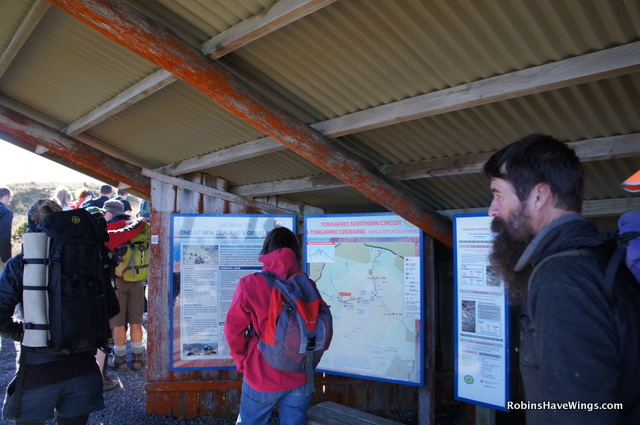
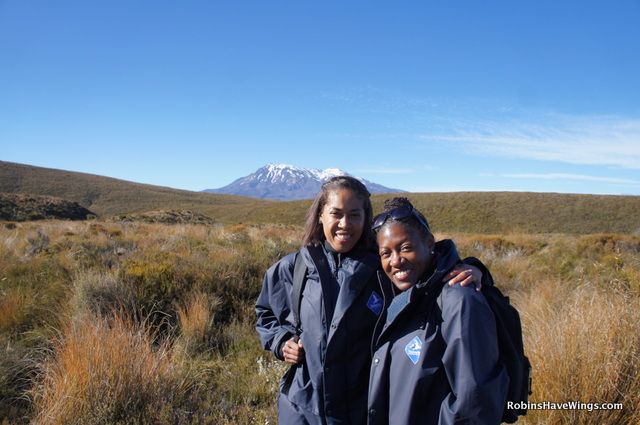
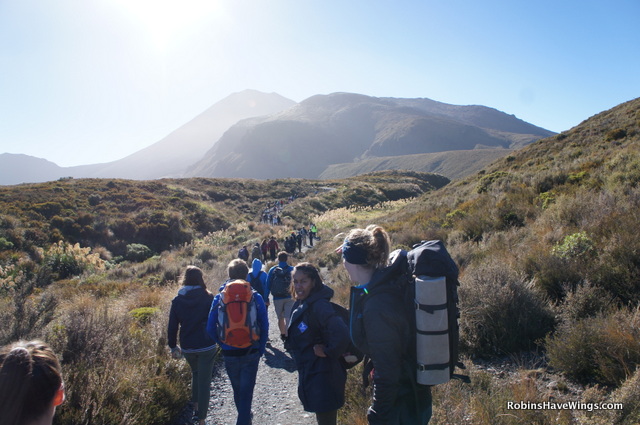
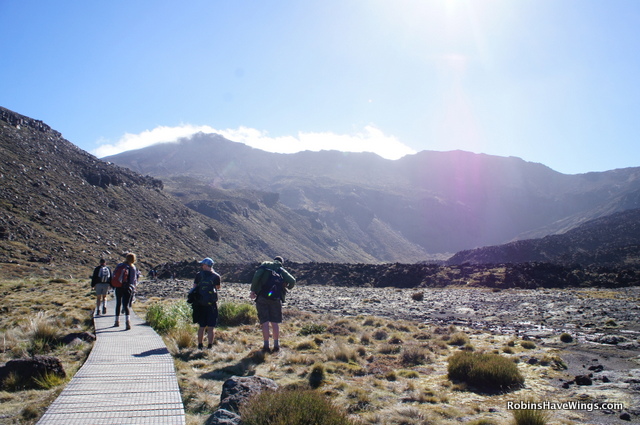
We start to scramble across some rocks alongside a pretty stream of water and small waterfalls appear. It’s here that we start to realize what a gorgeous day this is shaping up to be. The sun is high, the sky is a perfect blue and it is starting to warm. Not too long after this realization, we come to another realization that it’s time to put in some work, because we reached the “Devil’s Staircase” and we watch people trudge up a series of haphazard stairs built into the mountain. This is where a lot of people struggle, Mel says, adding that we shouldn’t stop because it is harder to keep going if you do. The key is to maintain a steady pace. Somehow at this point I am in the front and I’m in attack mode. I want to power up these stairs. I can see the next ridge and I’m using it as motivation. Behind me, Mel says, “Robin, you’re a machine.” I keep at it until my lungs tighten in protest. I’m practically wheezing and trying to catch my breath, while Tanya has fallen a bit behind. I tell Mel that I can’t keep the pace and she takes over, taking each step with a slight pause to slow the pace and Tanya and I are grateful. It allows us to recover and the walk feels a little more manageable. If I’d continued at the pace I set, I’d be one of the people we are passing, now, sitting at the edges of the stairs with withering looks of exhaustion.
Of course Mel’s words of encouragement help, “How are you doing, ladies?” “Is this pace OK?” “You’re doing great.” Before we know it we’ve conquered the Devil’s Staircase and Mt. Ngauruhoe, AKA Mt. Doom, looms next to us. Mel says we’ll see the mountain throughout our trek from varying perspectives, at times it will look smaller and at others bigger. We reward ourselves with a closer look for the moment and a water break. There’s a signpost here where previous trekkers have left their mark in stickers. Tanya and I think of an artist friend who has been leaving his bespectacled visage all over DC and we wish we’d thought to bring one of his stickers to leave behind.
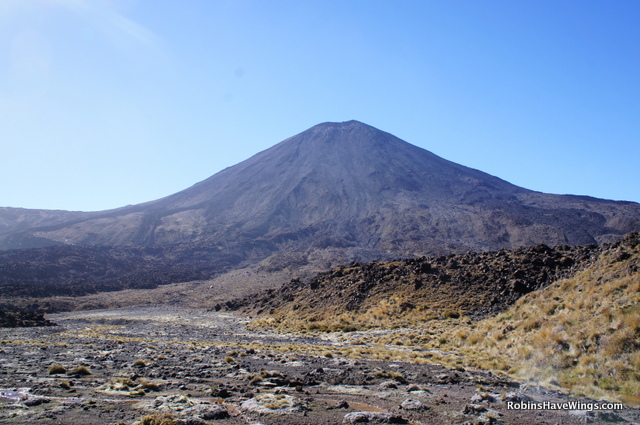
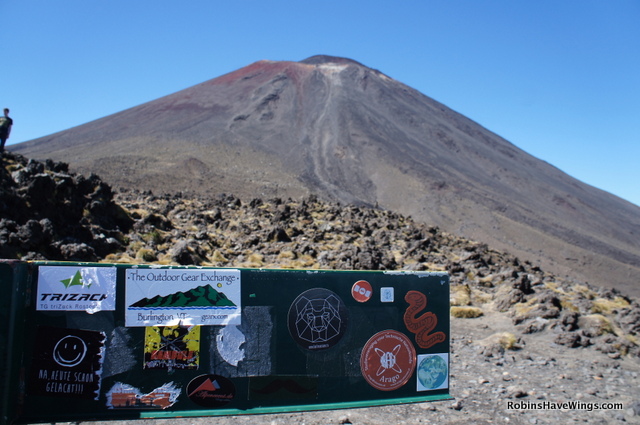
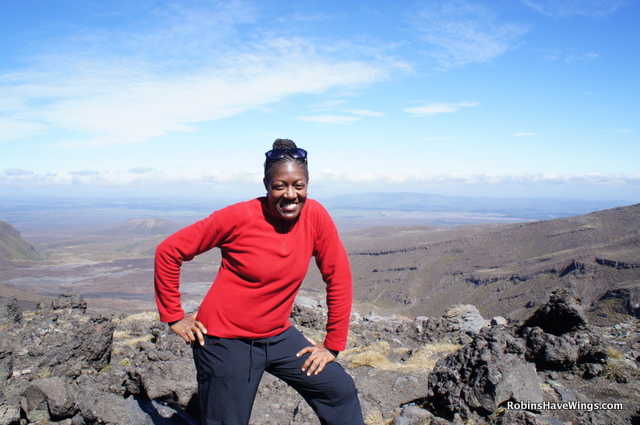
We’ll get even closer to Mt. Doom, but not before passing through the much heralded “Helm’s Deep,” site of the epic battle between the last men, elves, a white wizard and evil snarling orcs hell-bent on taking over Middle Earth in the Lord of the Rings movies. This part of our trek is a pleasant surprise, particularly for Tanya. We knew we’d be traveling in the shadow of Mt. Doom, but now, Helm’s Deep? Tanya is beside herself. (Further research suggests that our guide may have missed the mark here, Helms Deep was actually filmed near Wellington. Oh well, it sure looked like Helms Deep. Don’t tell Tanya.) She stands with arms outstretched in one of the few flat areas on the mountain, soaking in the Lord of the Rings aura.
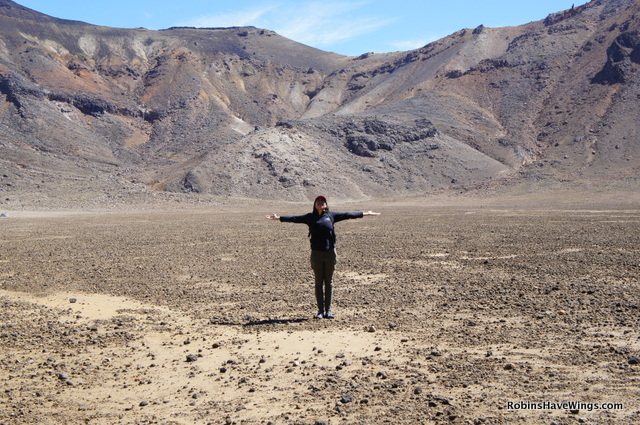
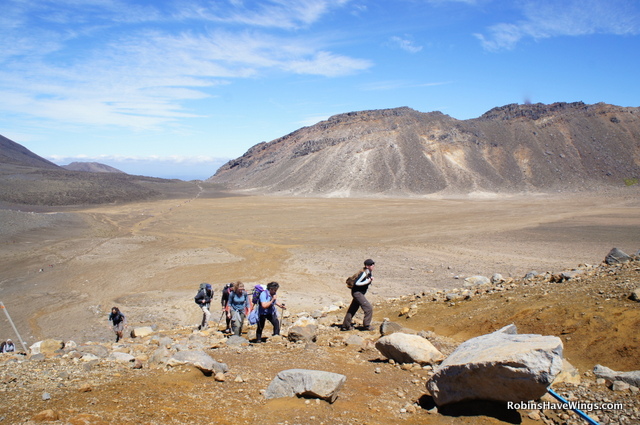
But we really are following in the footsteps of Frodo and Sam on the way to Mordor, and our own journey continues as we reach another ridge that we must scale taking us toward the Red Crater. Here the wind decides to attack us again, threatening to force us back down the mountain, but we are anchored by the stunning 360 views around us. The deep red soil surrounding a jagged crevice, evidence of previous lava flows, creates a stark contrast against the day’s crystal blue skies. It looks harsh and violent, yet beautiful and awesome at the same time. It also looks like something else. Tanya says, “Is it me, or does that look like a?” I say, “Yes, yes, it does.” We are both thinking of a part of the female anatomy and a Georgia O’Keefe painting flashes through my mind. We may have gotten a little loopy from the alpine altitudes.
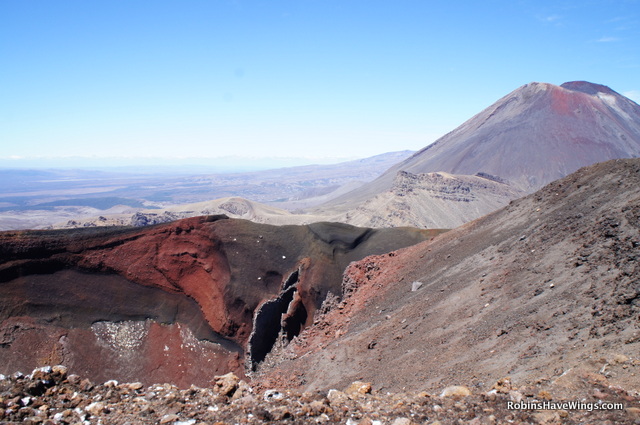
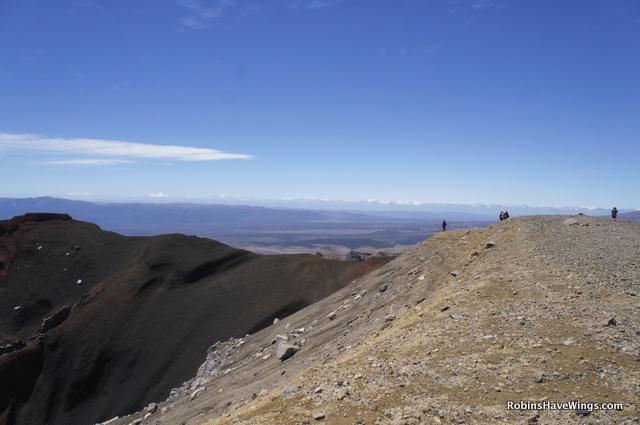
Just beyond the crater, we can see aquamarine sulfur pools, appropriately named the Blue Lake and the Emerald Lakes, glistening from the dark and desolate terrain. Mel has been telling us about this place. Every time, I stopped to take a photo of some amazing view, she’d say, “It gets better.” Well, she was right. I’m not sure where to aim my camera at this point, there are valleys, mountain peaks and pools to be captured in each direction. We’ve reached the highest point along the crossing at 1900 meters, over 1 mile high.
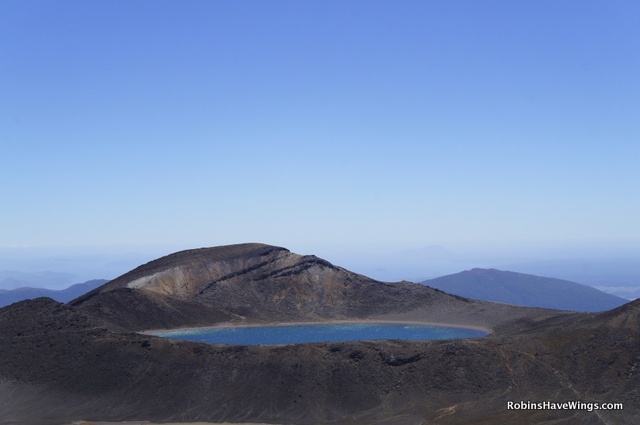
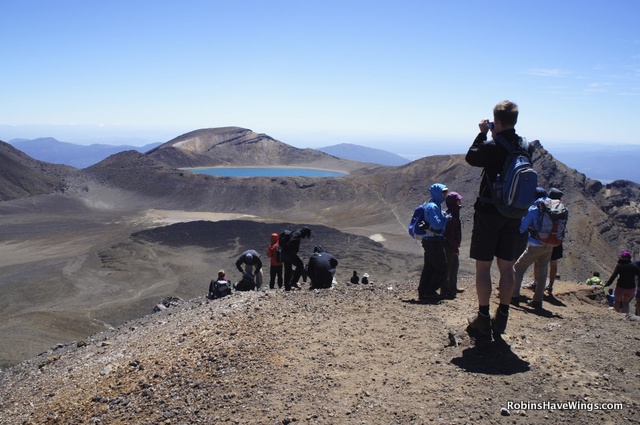
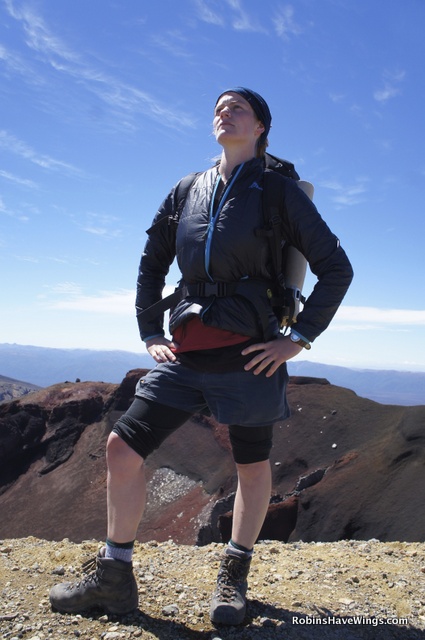
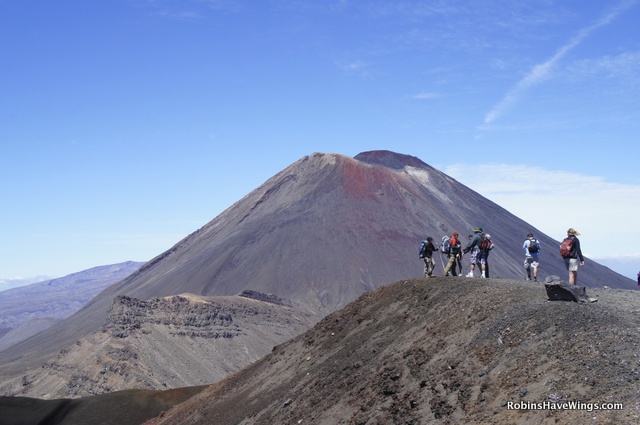
But we aren’t done and we still haven’t passed the most treacherous part of the trip. Mel tells us that we are going to have to do a kind of moonwalk through loose dirt to get to our next stop inside the South Crater. The dirt is actually volcanic rock and it is still steaming. The scent of sulfur rises in the air as we get closer to the Emerald Lakes in the crater below. Tanya and I are approaching this steep descent timidly, slowly inching downward and carefully placing our feet. We can imagine slipping off the narrow embankment packed with people into the Red Crater or worse into the pretty, but hot pools of sulfur below. The people around us don’t seem to be as cautious. In fact, they seem reckless, practically flinging themselves in haphazard fashion down the dusty hill sending ash flying. I trust my own steps, but I’m a little wary that some daredevil will take me out in their wild wake. Mel tells us that that some people have turned this into a sport, donning skis in the loose ash to make their descent. Tanya actually fell a couple of times and I managed to teeter and catch my balance in a few close calls.

It seemed to take forever, but we made it safely into the South Crater where we celebrate our ascent to the pinnacle of Tongariro and pause for lunch. Packed sandwiches never tasted so good, especially with the tea and coffee that Mel brought along. She also shared some tasty New Zealand chocolate with peanuts. Here we get to know Mel a bit more. She’s been working outdoors for 8 years, mostly with kids and teaching them teamwork. She’s been with Walking Legends for a year and she loves that it gives her a chance to walk and talk with adults. She says she wasn’t the best of students and instead of going straight to college she headed straight outdoors to the school of life. I’d say she made a good choice. But she’s giving school another shot, studying to become a paramedic. She says she wants to help people. I think she’ll be great at it. We sure appreciate her help on this trip because we never would have made it without her, especially the Devil’s Staircase and that hellish volcanic ash skiing business a moment ago. We probably would have turned back long before now, but instead we made a video from the top:
Just as we finish lunch, Tanya looks up to see a guy wearing a New Orleans Saints hat. Tanya hails from New Orleans originally, so she excitedly asks the guy if he’s from New Orleans. He explains that he lives in Paris, but all of his family lives in New Orleans and he visits often. She’s thrilled. What are the chances of meeting someone from your hometown on a mountain in New Zealand? I’d say 1 in a million. Before we part ways, he tells Tanya that the Saints have advanced in the playoffs. We take this news on the final descent down the mountain. Along the way, Mel tells us a Maori legend of the mountains we’ve passed. Pihanga was the fairest mountain maiden of them all and all the warrior mountains were in love with her, but she was married to Tongariro who was very jealous and erupted with anger at the other mountains, fighting them all until he was victorious and sending them away to their current places in the mountain range. But “word on the street” is that Pihanga still had a thing for one of the mountains, Tauhara, and the pair made love children in a range of smaller mountains near by.
I love hearing tales like this. Earlier, she told us the legend of how New Zealand was born when Maui, a Maori demi-god, went fishing with his brothers with a magic hook. Maui’s hook pulled up a gigantic fish and he was so proud that he wanted to offer it to the gods. He told his brothers the leave the fish alone, but they were jealous and the wanted it for themselves so they beat the fish, the beatings created the mountain ranges of the North Island, while the canoe they were fishing in became the South Island. A more scientific explanation suggests that the area around Tongariro was formed by eruptions from 6 volcanic cones along the same mountainous chain hundreds of thousands of years ago.
But the volcanic activity here is not a thing of the past. As recently as 2012, Tongariro erupted, sending flaming hot rocks into homes miles away and belching sulfur into the air that could be smelled as far as Auckland and Wellington. The resulting mudslides did their own lasting damage to the landscape. We can still see Tongariro belching smoke as we leave it behind us and wind our way down the mountain through a lovely valley where the vegetation has returned and we spy Lake Rotorira in the distance. It’s at this point that our bodies begin to scream at us particularly our knees and feet. They wonder what possessed us to inflict close to 8 hours of punishment on them.
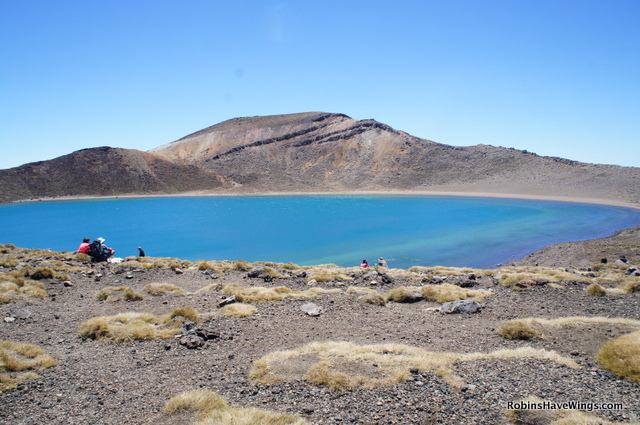
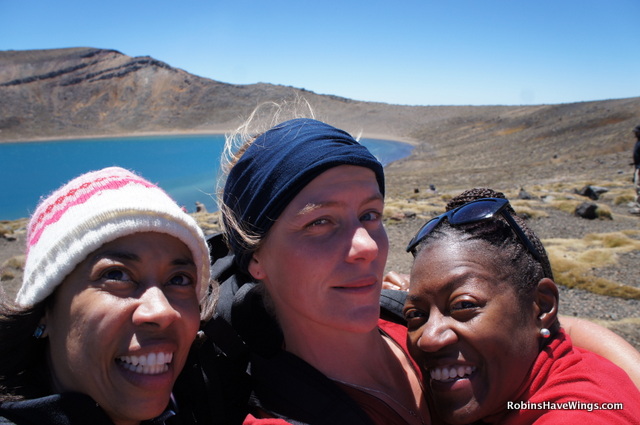
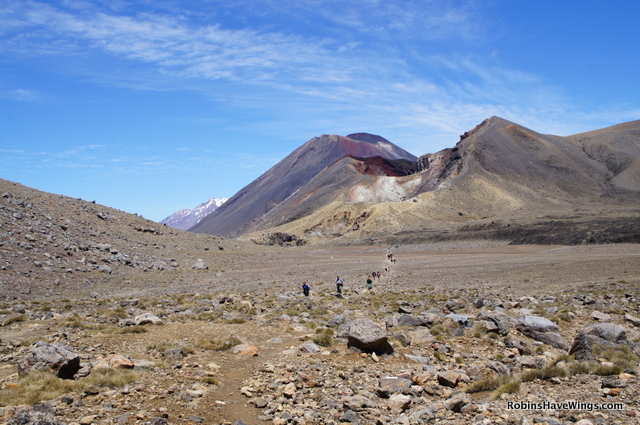
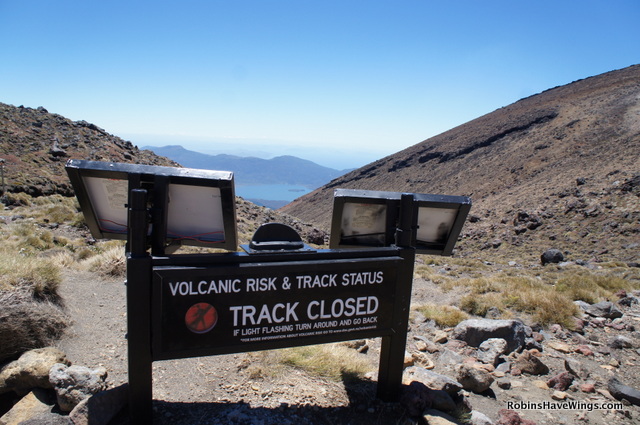
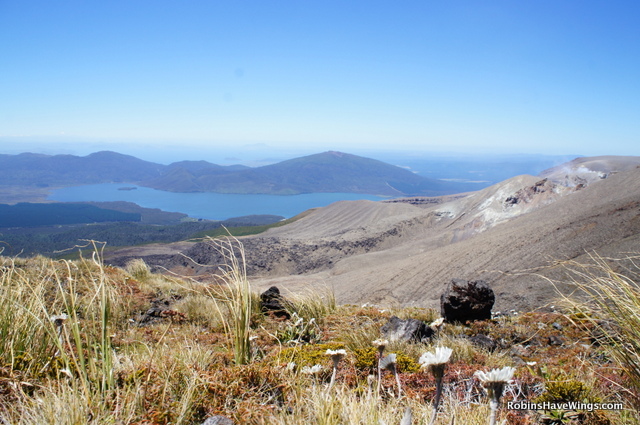
The zig-zaggy descent now feels like the longest part of our journey and Mel can sense that we are getting tired. She tells us about the plants that have begun to appear around us like the manuka, a pretty-smelling, delicate flower favored by local bees that produce New Zealand’s manuka honey and the flax plant that reminds me a bit of the gangly bird of paradise plant, used for years by Maori to make clothing. Earlier in our trip, Mel also pointed out the resilient mountain daisies with thick, hearty leaves that ward of frost and absorb water to survive long periods without rain. On a much needed chocolate break under a cool canopy of trees in an unexpected mountain forest, Mel invites us to taste the leaf of a pepper tree, once used as a numbing agent by dentists and sometimes added to spicy New Zealand dishes. Mel’s trivia is just one more thing that we love about this trip and it helps us forget how badly our knees and feet hurt. The chocolate was the perfect boost to keep us going another 30 minutes or so, moving at a steady clip to get us over knotted tree roots upended by the recent mudslides and across a fast moving stream to the light at the end of the forest…the car park. Tanya says, “Is that what I think it is?” And, it is. We’ve reached the parking lot and a covered sitting area where hikers who have reached this point before us are sitting quietly. It’s something I can’t understand and I ask, “Why is everyone so quiet? We made it to the end! People should be celebrating!” A few folks perked up with a cheer. Tanya, Mel and I cheer the loudest.
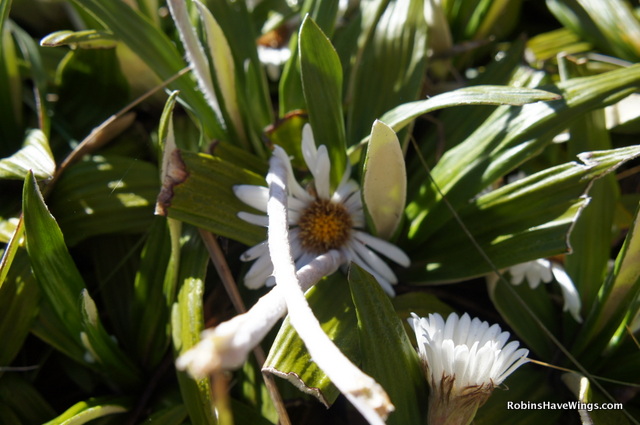

And, what better way to celebrate tramping from 8 am to 4 pm than with champagne? The Walking Legends crew is waiting for us with cold flutes of pink bubbly, not the après-hike drink most would envision, but one we totally appreciate. If we just liked Walking Legends before, the champagne made us fall totally in love. It was such a nice, thoughtful touch and we totally sing Mel’s praises to her boss. Before the champagne, we had a few stressful moments, thinking our bus to Rotorua had left without us, but it wasn’t our bus. Ours wasn’t scheduled to leave until 5, so we relax with our champagne, laying back in the grass still giddy over our accomplishment.
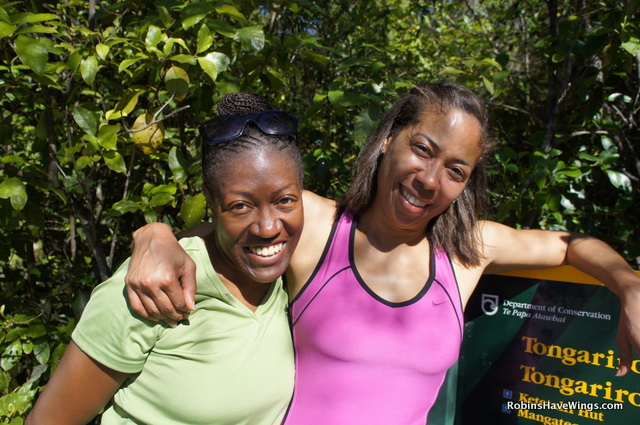
An hour later, we still haven’t left Tongariro because we are waiting for the group of Americans that traveled on the bus with us from Rotorua. Nelson, our bus driver is a little peeved. Nelson is rocking three gold chains and a thick gold rings on almost every finger. He’s like a Kiwi Mr. T and he’s ready to go. Finally, the New York-Massachusetts crew arrives looking a little worn and sunburned. They apologize for being so late. They thought they were making good time until they weren’t, stopping to offer help to a woman with a sprained ankle, and letting her companion borrow their phone. We swap Tongariro tales and Nelson softens in the front seat. Alyssa invites us for a dip in one of the thermal pools where she works at the Spa at QE. We take her up on the offer as we’d planned to hit the pools at the Polynesian Spa, but the Spa at QE is closer, just a block from our hotel.
The warm silken water from Rotorua’s active thermal pools is a welcome peace offering to our aching feet and knees. It makes me wish we’d had time for a thermal mud massage, too, but this will have to do, and it does. The company of our new friends is pretty cool, too.